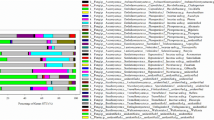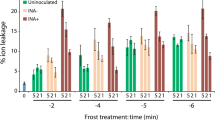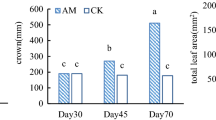Abstract
IN 1951, Miss Hyde1 obtained from the basal internode (about 1–2 in. long) of flowering stems of Barsée wheat and from stems immediately below the inflorescence, under aseptic conditions in culture plates, Alternaria tenuis in 40 and 43 stems out of 70. In 1953, I2 published a note on the apparent symbiotic nature of Alternaria tennis within the pericarp of some local wheat seeds. Since then, in the winters of 1953 and 1954, I carried out aseptic culture of our common wheat seeds within two sterilized glass chambers where aseptic seedlings from malt agar tubes were planted on sterilized manured soil, making provision for circulation of pure air which was sucked through cotton-wool in glass tubes by means of a water tap suction pump, and sterilized water, passing through a horizontal glass tube inserted through an air-tight hole on the chamber wall, dropped direct on the seedlings half an hour every day for two and a half months from early November. The two glass chambers were quite similarly fitted. In one glass chamber aseptic seedlings were prepared in the following way: wheat seeds were surface-sterilized with 0.1 per cent mercuric chloride for six minutes, washed three times in sterilized distilled water and planted in malt-agar tubes where they germinated into seedlings in the course of four days. In the other glass chamber Alternaria tenuis was eliminated from the aseptic seedlings in the following way: wheat seeds in sterilized water in a test-tube were exposed to a temperature of 53.5°–54° C. in a water-bath for ten minutes to kill Alternaria within the seed coat; they were then cooled, surface-sterilized with 0.1 per cent mercuric chloride for six minutes as before, washed three times in sterile distilled water and planted into malt-agar tubes for germination into seedlings. The temperature of two glass chambers was 10–15 degrees higher than that of the laboratory and they were usually in a very humid condition during the experiment. In the course of a month and a half it was found that the growth of plants and number of tillers under sterilized conditions in the glass chamber where A. tenuis was not eliminated were more vigorous and more numerous than those of the plants in the chamber where the Alternaria was eliminated by hot-water treatment. Thus, the presence of Alternaria tenuis within the wheat plants in this case seems distinctly helpful.
This is a preview of subscription content, access via your institution
Access options
Similar content being viewed by others
References
Hyde, M. B., Ann. App. Biol., 38, 348 (1951).
Bose, S. R., Science, 117, 16 (1953).
Hansen, E. H., and Christensen, J. J., Min. Agric. Exp. Sta. Tech. Bull., 206, 1 (1953).
Personal communication from a member of the staff of the Central Rice Research Institute, Cuttack.
Mehta, P. R., Plant Protection Bull., New Delhi, 2, 50 (1950).
Grainger, John, Trans. Brit. Mycol. Soc., 37, 412 (1954).
Author information
Authors and Affiliations
Rights and permissions
About this article
Cite this article
BOSE, S. Alternaria within the Pericarp of the Wheat Seed. Nature 178, 640–641 (1956). https://doi.org/10.1038/178640a0
Issue Date:
DOI: https://doi.org/10.1038/178640a0
This article is cited by
-
Studies on alternaria blight of wheat in Madhya Pradesh
Mycopathologia (1971)
Comments
By submitting a comment you agree to abide by our Terms and Community Guidelines. If you find something abusive or that does not comply with our terms or guidelines please flag it as inappropriate.



